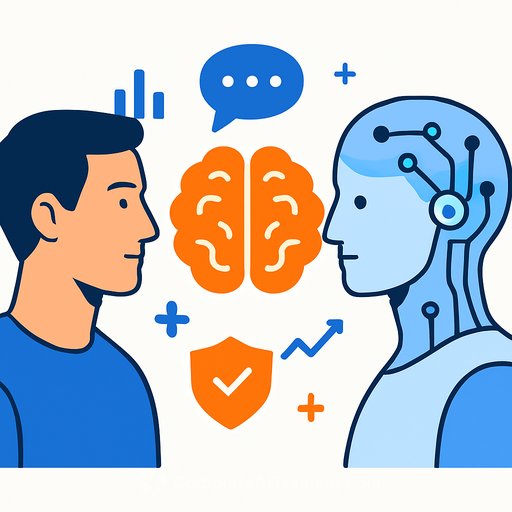Your AI "Twin" Could Soon Test and Treat Your Patients' Mental Health
Digital twins are virtual replicas of real systems that learn from live data and predict what happens next. They already support aircraft maintenance, industrial optimization, and personalized car design.
Healthcare is next. Cardiac digital twins simulate a patient's heart to test responses to arrhythmias and treatments without risk. The same approach can be applied to cognition and mental health.
What a Cognitive Digital Twin Is
A cognitive digital twin represents a person's brain and behavior using data from wearables, sleep sensors, smartphones, EHR, standardized cognitive tests, and symptom check-ins. It updates continuously as new signals arrive.
The model forecasts changes in attention, memory, mood, and function. It can recommend activities, behavioral supports, and clinical follow-up at the right moment-before issues escalate.
Why This Matters for Clinicians and Health Systems
- Earlier detection: Passive and active monitoring supports risk flags for depression, anxiety, delirium, MCI, and relapse.
- Precision interventions: Training plans and behavioral prompts are adjusted to the patient's current state, comorbidities, and response.
- Care efficiency: Automates routine monitoring so clinicians focus on exceptions and higher-acuity decisions.
- Trial enablement: Enriches cohorts, forecasts progression, and tracks digital endpoints for CNS studies.
- Population health: Stratifies risk across panels; aligns resources to those most likely to decline without support.
How It Works in Practice
- Onboarding: Consent, device setup (watch, ring, phone), baseline cognitive and mood assessments, and EHR linkage.
- Data flows: Heart rate variability, sleep architecture, activity, geolocation patterns, speech or typing cadence, medication adherence, and brief ecological surveys.
- Modeling: The twin learns each person's baseline and variability, then detects deviation and forecasts near-term risk.
- Interventions: Pushes micro-interventions (sleep hygiene prompts, stress reduction, cognitive tasks), schedules a check-in, or escalates to a clinician.
- Oversight: Clinician dashboard with trendlines, risk scores, explainable features, and "reason for alert."
- Feedback loop: Outcomes and adherence feed back to the twin to improve predictions.
Evidence Snapshot
Digital twins are established in cardiology and engineering. In cognition and mental health, evidence is growing. Meta-analyses suggest technology-based cognitive training can help delay or prevent decline in older adults, though effects vary by domain and program quality.
- Perspective on digital twins for precision medicine (Nature Medicine)
- Computerised cognitive training in healthy older adults (Cochrane Review)
Clinical Safeguards and Ethics
- Consent and transparency: Plain-language consent, clear data uses, opt-out options.
- Data minimization: Collect what you need, retain only as long as required.
- Privacy and security: End-to-end encryption, role-based access, audit trails, device and API hardening.
- Explainability: Show the signals behind risk scores and alerts; offer clinician overrides.
- Bias mitigation: Validate across age, sex, race/ethnicity, socioeconomic status, and device types; monitor for drift.
- Clinical governance: Multidisciplinary oversight (psychiatry, neurology, nursing, data science, ethics, legal) with clear escalation pathways.
Validation Before Scaling
- Analytical validity: Are sensors and algorithms accurate and reliable?
- Clinical validity: Do model outputs correlate with accepted clinical measures (e.g., PHQ-9, GAD-7, MoCA, neuropsych batteries)?
- Clinical utility: Do alerts and interventions improve outcomes, reduce admissions, or shorten time to response?
- Safety: False positives/negatives, alert fatigue, over-reliance risk; document human-in-the-loop checkpoints.
90-Day Pilot Plan
- Scope: One clinic or service line (e.g., outpatient psychiatry or memory clinic), 50-100 patients.
- Data stack: One wearable type, a short digital survey set, and EHR pulls for meds and diagnoses.
- Model focus: One outcome (e.g., relapse risk or sleep-driven mood instability) to limit complexity.
- Workflow: Triage rules, alert routing, clinician review cadence, and documentation templates.
- Metrics: Enrollment, data completeness, time-to-alert, clinician action rate, patient adherence, outcome change, and satisfaction.
- Review: Weekly safety huddles; 30/60/90-day go/no-go decisions with predefined criteria.
Practical Tips for Frontline Teams
- Start with patients already using wearables; reduce device burden.
- Keep surveys short and predictable; aim for under 2 minutes/day.
- Make every alert actionable; tie to a specific next step.
- Communicate value to patients: fewer crises, less guesswork, earlier support.
- Provide a "pause data" button to build trust.
Addressing Common Concerns
- "Will this replace clinicians?" No. It augments monitoring and triage so clinicians can focus on care decisions.
- "Will it widen disparities?" Plan for device loans, multilingual support, and low-tech options to reduce exclusion.
- "Is the algorithm a black box?" Favor explainable models and require feature-level rationales for alerts.
- "What about regulatory risk?" Map your use case to SaMD guidance, document validation, and keep a change log for model updates.
Bottom Line
Cognitive digital twins give healthcare a practical path to earlier detection, proactive support, and measurable outcomes in mental health. With the right safeguards, they fit cleanly into existing clinics and trials.
If your organization is preparing teams for AI-enabled workflows, you can explore role-based learning paths here: AI courses by job.
Your membership also unlocks:






